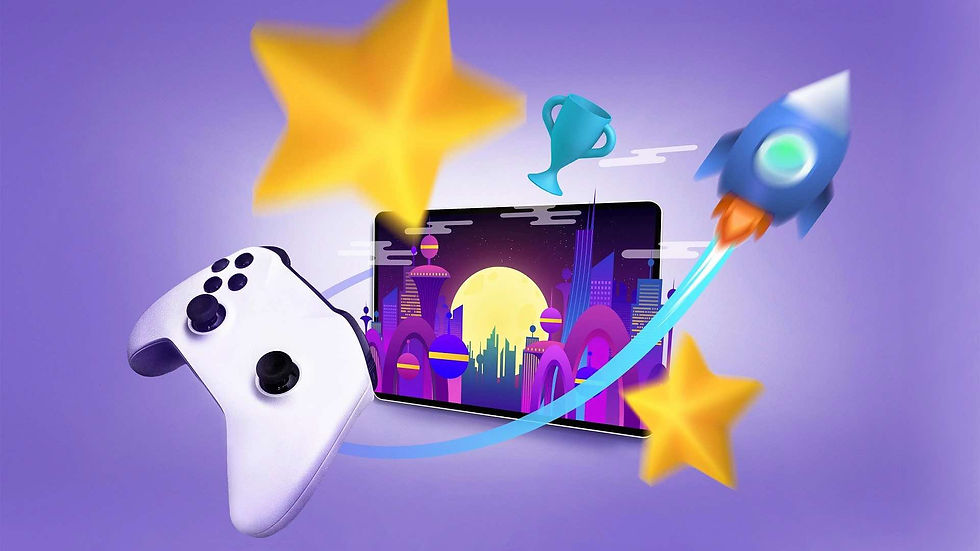Crypto x Gaming Economies: Real Assets in Virtual Worlds
- Bitcoinsguide.org

- Aug 18
- 3 min read
How blockchain transforms in-game assets into tradable, ownable, and income-generating property
Video games have always had their own economies.
From gold farming in World of Warcraft to rare skins in Counter-Strike, players have long assigned real-world value to virtual items.
But these were mostly grey markets—fragile, centralized, and easily banned by game publishers.
Today, blockchain technology is rewriting the rules.
With crypto, in-game assets become on-chain assets: verifiable, tradable, and truly owned by players.
This isn't just a gimmick—it’s the foundation for a new kind of global digital economy, where games are not only entertainment, but also sources of income, investment, and innovation.

What Are Crypto Gaming Economies?
Crypto gaming economies are virtual game worlds where players interact with blockchain-based assets. These assets include:
NFTs (non-fungible tokens): Represent unique items like characters, skins, weapons, or land
Fungible tokens: In-game currencies that can be earned, bought, or sold
Smart contracts: Govern game rules, asset ownership, and economic incentives
Unlike traditional games, crypto games allow players to truly own their digital goods.
Items live on-chain, not in a closed database. Players can sell, lend, or trade them without the game developer’s permission.
Key Benefits of Crypto Gaming Economies
Feature | Traditional Games | Crypto Gaming |
Ownership | Controlled by the game publisher | Players own assets via wallets |
Interoperability | Items limited to one game | Potential cross-game use |
Liquidity | Grey-market sales, no guarantees | Instant trading via marketplaces |
Monetization | Profit goes to publishers | Players can earn directly |
Persistence | Items lost if game shuts down | Assets remain on-chain forever |
Use Cases in Action
1. Play-to-Earn (P2E)
Early games like Axie Infinity pioneered the idea of earning tokens through gameplay.
Though P2E had sustainability issues, it proved the core value proposition: players want to earn for their time and skill.
2. Digital Land Ownership
Platforms like The Sandbox and Decentraland sell virtual land as NFTs. Landowners can host events, build businesses, or rent space—similar to real estate, but purely digital.
3. Skin and Asset Markets
Games like Big Time and Illuvium tokenize cosmetics and equipment. Players can trade them on marketplaces like OpenSea or Blur—gaming meets DeFi.
4. Interoperable Characters & Items
Projects like Ready Player Me aim to let avatars and gear travel between games and metaverses. While still early, this vision of cross-game identity is becoming a reality.
How Blockchain Enhances Game Design
Crypto doesn’t just add speculation—it enables entirely new game mechanics:
Provable scarcity: Supply caps and rarity are enforced by code
Composability: Developers can build on each other’s smart contracts
Programmable economies: DAOs can govern balance changes or monetary policies
Player-driven markets: Prices form organically via supply and demand
These features make games more dynamic, transparent, and economically rich.
Risks and Challenges
As promising as crypto gaming is, it comes with risks:
Speculation over gameplay: Some games attract players solely for token profits, not fun
Ponzi-like economics: Unsustainable reward loops can collapse when new players stop joining
Regulatory uncertainty: NFTs and tokens may fall under securities laws in some regions
Technical complexity: Onboarding to wallets, gas fees, and chains can deter casual gamers
The next wave of crypto games must solve these issues to go mainstream.
The Future: Where Crypto Meets GameFi and AI
Crypto gaming is evolving rapidly:
AI-driven NPCs and economies could simulate real-world complexity
Fully on-chain games (e.g. Loot Realms, Dark Forest) run entirely on smart contracts—no servers needed
GameFi platforms integrate DeFi mechanics into gaming (staking, liquidity mining, etc.)
Social gaming DAOs let communities co-create, fund, and govern games
Ultimately, games may become fully sovereign economies—complete with their own GDP, jobs, and governance models.

Conclusion: Play, Earn, Own, Build
Crypto gaming is more than a trend—it’s the financialization of play.
For the first time, players can own a piece of the games they love, earn real income through skill and effort, and participate in game development as stakeholders, not just consumers.
As blockchain infrastructure matures and game design improves, the line between work and play will blur—and virtual economies could rival real-world ones.
Want to stay ahead of the curve in crypto gaming and blockchain tech?
Register at bitcoinsguide.org and get weekly insights, tools, and guides delivered straight to your inbox.



Comments